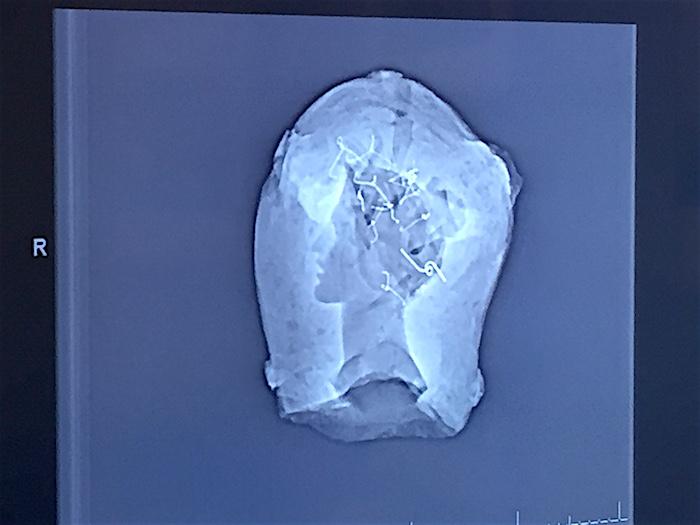
CT Scanning reveals the sculptural form inside a 100-year-old Saint-Gaudens mold/NPS
Sometimes you need to look beyond the surface of an object to appreciate its true beauty. That certainly can be said now of a number of plaster-encased molds that had been stashed away at Saint-Gaudens National Historic Site in New Hampshire.
For more than a century there has been a mystery surrounding about two dozen molds that sculptor Augustus Saint-Gaudens and his assistants had encased in plaster and then placed them into storage for safekeeping. Since then, the molds have passed from the Saint-Gaudens family to the non-profit Saint-Gaudens Memorial to the National Park Service, and also survived a catastrophic studio fire in 1944, according to the Park Service. Through the years, the identities of many of these sealed molds had been lost. Until now.
The National Park Service at Saint-Gaudens National Historic Site and the Department of Diagnostic Radiology at Dartmouth-Hitchcock’s medical center in Lebanon, New Hampshire, formed a partnership to non-invasively peek at what these molds contain.
With computed tomography (CT) scanning, normally used for creating an image of the inside of a patient’s body without surgical intervention, radiologists were able to scan the open interior spaces of these molds and then extrapolate the negative space into a positive digital image of what these molds would have been used to cast. They have also taken the additional step of converting these CT scans into stereolithography which have been used to 3-D print casts of these original Saint-Gaudens works.
The 3-D printed casts of these works are on display in a gallery exhibit at Dartmouth-Hitchcock until March 2018. The exhibit will be on display in the main entrance rotunda.
“This is an amazing partnership at the intersection of art, science, and history,” said Rick Kendall, superintendent of Saint-Gaudens National Historic Site. “These scans and the resulting 3D prints have literally turned the empty space in these molds into fine works of art that haven’t been seen in a century—something from nothing.”
The molds were revealed to be from sculptural commissions that Saint-Gaudens and his assistants were working to complete close to the end of the sculptor's life. The CT scans revealed that the molds included pieces from the following Saint-Gaudens works: Abraham Lincoln: The Head of State (original cast in Chicago, Illinois), the Phillips Brooks Monument (original cast in Boston, Massachusetts), the Sherman Monument, (original cast in New York City, New York), and a bust of politician William C. Whitney. A website showing examples of the scanned objects which allows the public to manipulate these scans in three dimensions can be found here.
Perhaps the most interesting piece was a small mold, slightly larger than a football, park staff said. The scan revealed a very small bust, less than a foot high, of a man with a close-cropped beard; a face that no Saint-Gaudens experts have been able to identify. This small bust is new to art history, not previously part of the Saint-Gaudens sculptural catalog, and may have been a study for a larger piece that was never completed after the artist died in 1907.
Molds are an important part of the process of creating bronze sculpture. Figurative sculptors typically start modeling a sculpture in clay. After undertaking an enlarging process, sculptors typically take a mold of their final version of the piece which captures all of the surface details of their work. The mold is then used to cast the final version in bronze.
Today, sculptors use high-temperature rubber for sculpture molds; in Saint-Gaudens’ time, plaster was the medium of choice. The exterior of the plaster molds would be encased in a second, heavier jacket of plaster reinforced with iron called an investment mold. The two sides of the investment mold would fit together like a clam shell to create a full 360-degree mold that would open in order to release the bronze cast. For storage or shipment, these clam shell molds were then often sealed with dabs of plaster to protect the fragile interior details from cracks and abrasions that would impact the final cast.
Augustus Saint-Gaudens (1848-1907) was the preeminent American sculptor of the Gilded Age and is perhaps best known for his Civil War-era memorials and monuments. His major monuments and smaller works are located in public spaces and art museums around the country and the world. He and his multiple generations of studio assistants who were highly successful in their own right put American sculpture on a global footing. His home, studios, gardens, and personal collection of museum art pieces are now preserved as Saint-Gaudens National Historic Site in Cornish, New Hampshire.

 Support Essential Coverage of Essential Places
Support Essential Coverage of Essential Places






